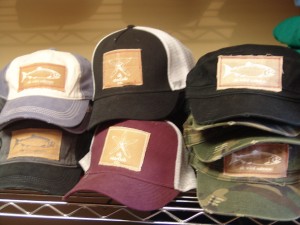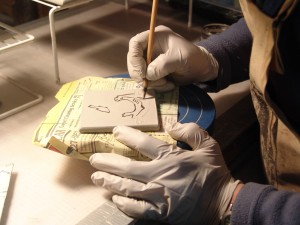It’s winter and I really needed to get out of my studio and find some color and yes, some texture. I’ve been hunkered down reading my PhD art-philosophy homework—thinking about whether Heidegger’s answers to life’s debacles can be solved through art or whether Rancière’s ideas will permit artists to once again share in the art-speak.
So I headed to the AK Starfish Co., owned and operated by Marci Nelson, a third generation Alaskan. My readers know I love connections — I met Marci’s mom in the early seventies through work colleagues of my husband, Dave.
Marci studied science and literature at the University of Puget Sound. Before beginning her sixteen years of teaching Shakespeare to Dimond High students, she taught English at a banking college in Guangzhou, China. Marci’s love of the Alaskan outdoors and an appreciation for nature’s beauty led her to render sea creatures, flowers and wildlife using pen and ink, which soon ended up on her locally screened collections of shirts and pants.
What began as hawking t-shirts at seasonal markets around the state, led to a wholesale business of unique American-made apparel. In 2009. Marci opened her Spenard store. Seasonal shops in Homer and Seward quickly followed as did the shop adjacent to Glacier Brew House. Another Marci Nelson emporium is about to open in the Dimond mall area.
Entering AK Starfish Co. is like skidding onto a painter’s palette. Floor to ceiling racks of t-shirts, sweatshirts and aerobic wear allow you to enjoy this house of eye candy before contemplating your purchase. Perchance a long sleeved tee or a hooded outer garment will delight. Antique tables below funky chandeliers and mirroring provide contrast in this sea of warm and cool coloring. Nelson employs friends and former students who share in discussions about successful items and future orders. With approaching summer, Marci will be stocking shift-style dresses she found when vacationing on Maui.
Wearing rubber fishing boots below layers of starfish jersey, the salesperson spoke about the appeal of salmon pink and pointed to jewelry made by local craftsman. At present, Marci features four pen and ink images: starfish, raven, salmon and fireweed. Unlike college bling that’s meant to be garish, her designs are sophisticated, minimal and quiet. I imagined wearing one of Marci’s t-shirts over khakis or a long skirt. Add a string of beads and you could easily appear dressed for a bbq or college reunion cocktail party.
In a corner by some worn buoys that had morphed into store-props, was a pile of hats emblazoned with – ak starfish co. – above each bill.The clerk giggled as she told me that the material used to make the logos were once on legs of those employed to maintain Alaska’s famed pipeline.
OK, I needed more explanation. Marci cuts-up old Carhartts, preferably ones worn by sweaty-beefy Slope workers. These rectangles get locally printed with ak starfish co. and sewn onto baseball caps to the delight of locals and tourists seeking some Alaskan DNA. Not only is Nelson supporting the local economy, she is marketing wearable art.
I was in need of some artistic texture before I headed back to my PhD readings of incessant contemplation on why humans create. So I headed to Ed Mighell’s clay studio in Fairview. Ed, like Marci, supports himself by making art. Although Mighell is part Inupiaq, he grew up in Colorado with some oversees schooling in Ethiopia when his dad worked as an engineer. He also got an engineering degree and spent years building roads in the Bush, becoming an expert in freeze-back or building on permafrost. One of Mighell’s engineering professors at University of Alaska, Anchorage was Marci Nelson’s dad. I love when my friends are aesthetically connected!
In the nineties, Mighell began taking fine art classes also at UAA. A BFA degree in printmaking wasn’t complete without a 3-D ceramics class. Both disciplines would later become the foundation of his practice. Ed and I first met in a Joan Kimura painting class. He remembered my acrylic abstracts done on 300 lb watercolor paper. Kimura was a taskmaster and made her students paint two works per week so there wasn’t time to stretch canvas. In 2003, Mighell quit civil engineering to make a living doing what he calls ‘printmaking on clay tiles.’ I watched Ed carefully outline his raised animations using a brush of waxy-goo.
His original designs, somewhat abstract plants and creatures, get stenciled onto tiles that go through a press and thus are raised above their tile base. Mighell prefers an old monograph machine rather than one designed specifically for clay. This wax keeps colors from running into each other and will vaporize in the firing. He has two kilns and has perfected single firing to save energy.
Mighell has also perfected the art of using Cook Inlet clay to make his tiles. In the late fall Mighell digs glacial clay from his special spot somewhere in Turnagain’s former earthquake area. The clay is dried and sieved. Commercial clay and other chemicals are added for stabilization. Tiles pop out of his ovens with minimal shrinkage and warping, the result of secrets he coyly refused to divulge. Mighell makes his own glazes, and like those who perfect ceramic coloring, the artist must know the chemical composition of the colors that enter the kiln and what colors will emerge.
When I engage with those who muck about with clay, I am always glad that back in my studio my acrylic paint won’t change much when applied to canvas. It’s clear that years of engineering has helped Mighell perfect his ‘printmaking on clay.’ His math skills have helped him calculate overhead and profit per-tile-unit. Working alone in a studio can become hours of procrastination. Mighell puts artists to shame with his self-discipline. He works with an imaginary taskmaster cracking a mythical whip. Mighell allows himself few breaks and even manages to get to the gym three days a week. Just as I am thinking artist Ed was too dedicated to be real, he trumped me again by producing his journal—he draws and takes notes daily for at least ten minutes.
Influenced by German Expressionism and the French café artist Toulouse Lautrec, Mighell often heads to the Anchorage Museum to research ancient designs crafted on the West and North coasts of Alaska. He combines his college education with his Native Alaskan heritage to execute animals and sea creatures in earth tones with just enough primaries and whimsy to make them exquisite. Mighell updates traditional circular patterns which fill and juxtapose his square tiles. Customers can purchase at local and out-of-state fairs he frequents (AFN Convention, Anchorage Museum, Fur Rendezvous), accenting a bathroom or dramatizing with a fireplace backsplash or just enjoying individual tiles as a one-of-a- kind art.
Another aesthetic connection–Ed met Marci at the Anchorage Weekend Market. Recently Mighell completed a project for NANA’s relocation to the former Unocal building where his dolly varden, arctic char and pike encircle tiles dinner-plate-size. Native circular designs were practical story telling systems which could fill a drum head or encompass bowls. Mighell, whose mother came from Point Hope, says pottery shards there date back 5000 years and the last Native Alaskan potter died around 1880; he considers himself unique.
It’s not easy abandoning conventional employment like Marci’s teaching or Ed’s engineering to make a living in art. I consider myself a “Cinderella” artist preferring the security of working at my husband’s law office. If I get the filing done before lunch, I can “go to the ball” or make art in the afternoon. But, my trade-off is less time with paint brushes and less writing on my computer. Marci Nelson began selling her art out of her condo before she opened a retail outlet (www.akstarfish.com). Ed straddled his engineering career before full-time digging in Cook Inlet (www.edmighell.wordpress.com), a Silver Hand Alaskan Native artist.
I love being a studio hermit but visiting with other artists is essential for continual artistic growth. Between Marci’s color combinations and Ed’s aesthetics pressed into tiles, I was truly enriched and ready to head back to my PhD assignments. Oh yes, there’s the gym I need to shoehorn into my already overtaxed painting time.
(Note: special thanks to the staff of AK Starfish Co. Their loyalty to Marci Nelson was exemplary. Marci was on jury duty when I visited her store).






